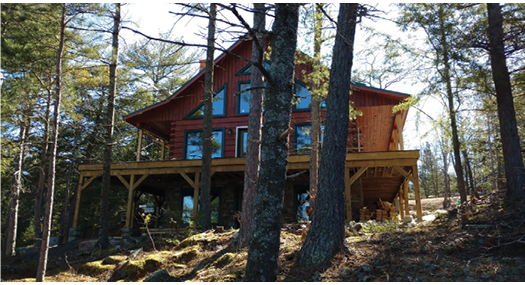By Bernard Aschwanden | STC Associate Fellow
Any documentation project starts with an end goal. The same can be said about building a house. About 10 years ago, my wife Vivian and I bought an acre of land. We hoped that within 10 to 15 years, we’d have a chance to build a mythical beast: a log home on a lake, surrounded by trees, on time, and within a realistic budget.
It’s important to start with a good foundation. In a documentation project, you want a clear idea of the finished product (the software, hardware, services to deliver, or whatever your company produces).
For a house, the foundation makes all the difference. Once we saw the shoreline, we contracted to build a topographical map to see the structural layout of what we had.
With an understanding of the lay of the land, we could identify the home we wanted and find a supplier. We wanted someone with a track record, a good understanding of what we wanted, and a personality fit, and Steve at True North Log Homes was our eventual choice.
We looked at plans, scoped out what worked for us, customized it, and got input on material costs and what we might expect the entire project to cost. Now we knew what might impact the delivery of the finished product, and had an estimate of cost and time. We needed framers, plumbers, electricians, heavy equipment operators, engineers, and masons. There would be costs for clearing land, building a foundation and basement, adding a fireplace, stairs, deck, doors, and windows. We had to price water, septic, heating, cooling, and electrical services. Once priced, we added about 25% to the budget for stuff we missed! We had to carefully track how much was spent.
Projects require reading supporting content. We read information about every part of the house: bylaws, building code, types of materials, contracts, and more. We had to learn the jargon of various trades, know how it connected to other workers, and integrate what it said into the overall plan. After all, the audience makes all the difference in technical communication.

We also had jobsite health and safety to think about: safety boots, glasses, gloves, properly fitted clothes, and insurance for damage. We had to ensure ice/snow was cleared away, and water to stay hydrated was needed. Keeping people safe is always a consideration when you have so many moving parts on a project.
Once all the details were resolved, we started to build the foundation, which went in surprisingly quickly. Once planned, a solid base with in-floor heating was poured, and concrete filled the base and the ICF walls. With the foundation in place, we were able to lay the main floor and start to add logs! After that, it was time to apply a stain and start the second floor. The exterior shell of the building went up very quickly, but finer details took time.
Now we are into the building interior. That means time to talk with the contractors, co-ordinate schedules, review plans with each specialist in a given trade, ensure neighbors are kept happy, and make long trips to and from the job site. But at the end of the day, we’ll have a chance to sit on the deck, or just relax on a bench and watch the sun set as we enjoy a cold drink.
How does it all connect to documentation? Our background in tech comm means we have the skills and experience to deal with various professionals, communicate our needs, manage when change is unexpected, be creative with solutions, and still deliver a top-quality product!
See you at the dock after work?
To see more pictures, visit https://goo.gl/photos/aLcbbtka1nL8cUWE6 and, please, add comments with your thoughts or questions!


